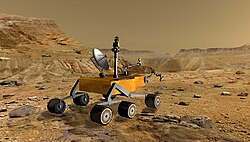PIA18089-Preparatory Drilling Test on Martian Target Windjana
NASA's Curiosity Mars rover completed a shallow "mini drill" activity on April 29, 2014, as part of evaluating a rock target called "Windjana" for possible full-depth drilling to collect powdered sample material from the rock's interior. This image from Curiosity's Mars Hand Lens Imager (MAHLI) instrument shows the hole and tailings resulting from the mini drill test. The hole is 0.63 inch (1.6 centimeters) in diameter and about 0.8 inch (2 centimeters) deep.
When collecting sample material, the rover's hammering drill bores as deep as 2.5 inches (6.4 centimeters). This preparatory activity enables the rover team to evaluate interaction between the drill and this particular rock and to view the potential sample-collection target's interior and tailings. Both the mini drill activity and acquisition of this image occurred during the 615th Martian day, or sol, of Curiosity's work on Mars (April 29, 2014).
MAHLI was built by Malin Space Science Systems, San Diego. NASA's Jet Propulsion Laboratory, a division of the California Institute of Technology in Pasadena, manages the Mars Science Laboratory Project for the NASA Science Mission Directorate, Washington. JPL designed and built the project's Curiosity rover.Relevante Bilder
Relevante Artikel
Mars Science LaboratoryMars Science Laboratory ist eine NASA-Mission im Rahmen des Flagship-Programms, die den Mars hinsichtlich seiner aktuellen und vergangenen Eignung als Biosphäre erforscht. Hierzu wurde auf der Oberfläche ein weitgehend autonomer Rover mit dem Namen Curiosity abgesetzt, der mit zehn Instrumenten zur Untersuchung von Gestein, Atmosphäre und Strahlung ausgerüstet ist. Zu deren Analyse kommen neben einer großen Zahl unterschiedlicher Spektrografen auch Kameras und meteorologische Instrumente zum Einsatz, welche die Messdaten für die Auswertung zur Erde schicken. Mit einer Masse von 900 kg und der Größe eines kompakten Kleinwagens war Curiosity bis zur Landung von Perseverance im Februar 2021 das schwerste von Menschen geschaffene Objekt auf der Marsoberfläche und löste die Viking-Tochtersonden mit je knapp 600 kg ab. .. weiterlesen










































